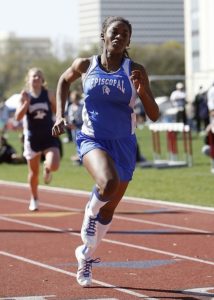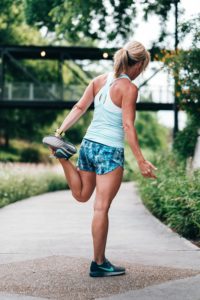By Dr. Michael Falk, PT, DPT, ATC, CSCS, special to SportsMD.com

Every sports fan has watched a player from their favorite team pull up, grab the back of their thigh, and hobble off the field gingerly. And everyone knows what has just happened—the dreaded hamstring strain. In field sports, approximately 15 to 25 percent of players will sustain a hamstring strain during a given season.
The average time out of competition from this injury is around 18 days, but one study found that it takes almost 16 weeks for the player to return to pre-injury form. The good news is that muscle strains generally heal on their own over time and rarely require more substantial medical intervention. The bad news is that the re-injury rates are extremely high—as high as 30 percent, depending on which research study you look at.
So why do hamstring strains happen? And what are important factors to successfully return to play AND reduce your risk of re-injury after you sustain a hamstring strain?
What contributes to a hamstring strain?

Most hamstring strains occur while sprinting, and particularly while sprinting at near maximum speed. The hamstring slows down the lower portion of your leg during the sprinting stride. That muscular action happens very quickly at very high force with the hamstring in an elongated position. So, high stress on the hamstring with the muscle in a weaker position equals hamstring strain.
Some assume that “tight” or “short” hamstrings are a primary risk factor for hamstring strains. While optimal hamstring length is important, the most important risk factor is hamstring weakness, particularly at very lengthened positions (like the position during sprinting). Building on this idea, a rapid increase in an athlete’s high-speed running early in a sports season or during training camp can also contribute to hamstring strains. If an athlete has not done much high speed running during the off-season, rapid exposure to training camp or game play can put the hamstring at higher risk of injury. So, weak hamstring plus using it more equals more hamstring injuries.
Keys to Rehabilitation:

As we noted above, the average player returns to play two to three weeks after an injury and still has a substantial risk of re-injury. So why is that? A few research papers have shown that strength deficits persist much longer than when the player feels good enough to return to the field. Here’s some data from one study:
Strength % – Injured Hamstring vs. Un-injured Hamstring
- Week 2: 70%
- Week 4: 85%
- Week 6: 90%
Regaining strength is extremely important and should be one of the main components of an athlete’s hamstring rehabilitation. A common mistake we see is athletes being told to rest for a substantial period of time and do very little active rehabilitation to improve their hamstring strength, motion and re-integration into running.

We recommend relative rest rather than complete rest. Relative rest means staying as active as possible but avoiding activity that causes pain or makes the injury worse. For example, athletes may not be able to run at high speeds immediately following the injury, but should begin low level strengthening within a day or two of the injury. Then progress the hamstring strengthening exercises as they are able to tolerate it with an emphasis on gaining strength in long muscle positions (with your knees relatively straight).
Here are two exercise examples for working on this quality (please consult with your rehabilitation professional before implementing these exercises in your recovery).
Easier:
Harder:
Additionally, athletes should run, and run at high speeds during their hamstring rehabilitation prior to returning back to the field. Generally, athletes will be able to begin with a pain free jog to work on conditioning and get the hamstring used to the running motion. As running speed increases, add short sprint distances like a three to five yard acceleration. The hamstring works hardest and is most at risk of re-injury at maximal speed, so beginning with short distances allows the athlete to move quickly in a relatively safe manner. From there, athletes can progress to longer sprint distances as they recover.
Get a Telehealth Appointment or Second Opinion With a World-Renowned Orthopedic Doctor
 Telehealth appointments or Second Opinions with a top orthopedic doctor is a way to learn about what’s causing your pain and getting a treatment plan. SportsMD’s Telehealth and Second Opinion Service gives you the same level of orthopedic care provided to top professional athletes! All from the comfort of your home.. Learn more via SportsMD’s Telemedicine and Second Opinion Service.
Telehealth appointments or Second Opinions with a top orthopedic doctor is a way to learn about what’s causing your pain and getting a treatment plan. SportsMD’s Telehealth and Second Opinion Service gives you the same level of orthopedic care provided to top professional athletes! All from the comfort of your home.. Learn more via SportsMD’s Telemedicine and Second Opinion Service.
Conclusion:
Hamstring strains happen often and the re-injury rate is high. That’s why it is so important to actively rehab from the injury including strength training at long muscle lengths and a planned return to running, sprinting, practice and competition.
References:
- Askling, C. , Karlsson, J. and Thorstensson, A. (2003), Hamstring injury occurrence in elite soccer players after preseason strength training with eccentric overload. Scandinavian Journal of Medicine & Science in Sports, 13: 244-250. doi:10.1034/j.1600-0838.2003.00312.x
- Croisier, J.-L., Ganteaume, S., Binet, J., Genty, M., & Ferret, J.-M. (2008). Strength Imbalances and Prevention of Hamstring Injury in Professional Soccer Players: A Prospective Study. The American Journal of Sports Medicine, 36(8), 1469–1475. https://doi.org/10.1177/0363546508316764
- Petersen J, Hölmich P. Evidence based prevention of hamstring injuries in sport. British Journal of Sports Medicine 2005;39:319-323
- Cronin, John. “Leg asymmetries during running in Australian rules football players with previous hamstring injuries.” The Journal of Strength & Conditioning Research 24 (2010): 1.
- Ribeiro-Alvares, João Breno, et al. “Four weeks of Nordic hamstring exercise reduce muscle injury risk factors in young adults.” The Journal of Strength & Conditioning Research 32.5 (2018): 1254-1262.
- Hickey, J., et al. “Pain-free vs pain-threshold rehabilitation for acute hamstring strain injury: A randomised controlled trial.” Journal of Science and Medicine in Sport 20 (2017): 11.
- Heiderscheit, Bryan C., et al. “Identifying the time of occurrence of a hamstring strain injury during treadmill running: a case study.” Clinical Biomechanics 20.10 (2005): 1072-1078.
Cover Image: Unsplash/Alexander Mils
